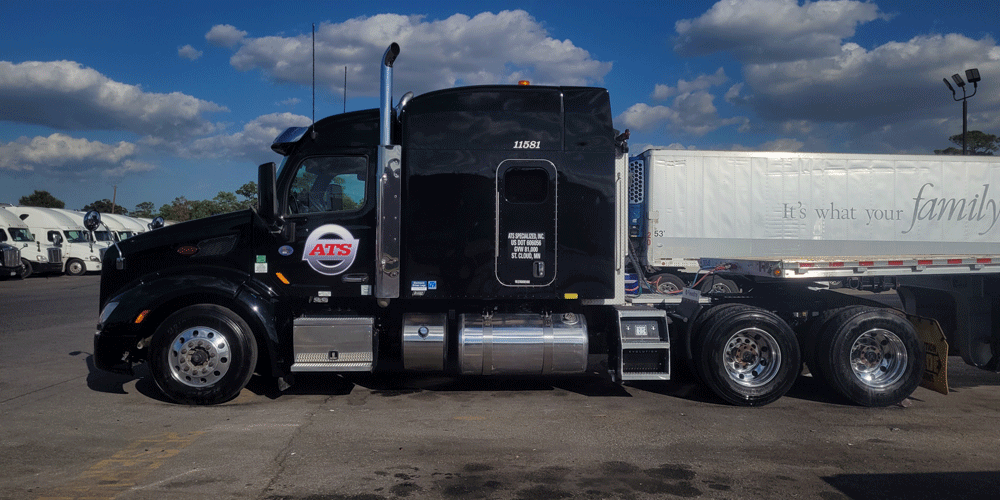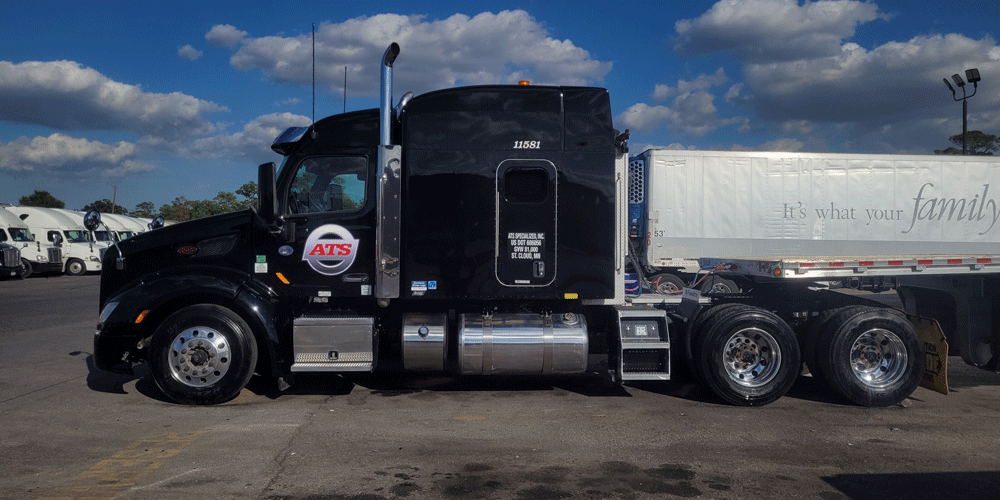Truck Driver Road Test in 2025: What to Expect & How to Prepare
Terri is a safety specialist at ATS. She helps facilitate driver orientation for company drivers in Porter, Indiana. She welcomes new drivers, makes sure they’re given proper ATS training, and helps complete their driver files. Before coming to ATS in 2019, she was a truck driver for nearly 20 years. She has experience as both a local, regional, and OTR truck driver. She eventually started her own trucking company with four trucks and trailers, where she hired drivers, stayed up on FMCSA regulations, booked freight, dispatched drivers, scheduled repairs, administered permits, and did payroll. Terri enjoys helping drivers and giving them the tools they need to be successful at ATS.
Key Takeaways for Drivers:
- Road tests are required for all drivers, even experienced ones
- Tests cover pre-trip inspections, equipment operation, driving in traffic, backing & parking
- Evaluators will focus on safety, control, and eliminating bad habits
- Additional training on ATS's simulators can help drivers improve if they struggle initially
Spend a few moments sitting in an orientation class and you’ll hear the stirrings of nervous drivers who aren’t sure what to expect from their road test.
How intense will it be? Where are they going to take me? How long is it going to take? Am I going to fail?
Even though you’re a professional driver, you can still get a little nervous when it comes down to being judged on your skills. It can be nerve-racking, especially when you’re trying to get in at a company that you’re really excited about. You don’t want to fail, and we certainly don’t want you to fail.
Are you worried about what to expect from the Anderson Trucking Service (ATS) road test?
Well, I'm here to tell you there’s nothing to be worried about. The road test shouldn’t make you nervous (though it’s totally understandable if it does). It’s just a way to show the company you know what you’re doing.
Nonetheless, I'm going to provide you with a comprehensive list of everything we cover in a road test so you know how to prepare yourself. I help facilitate driver orientation for company drivers in Porter, Indiana. One of my duties is to prepare drivers for their road tests and conduct the tests themselves.
Here are my best insider tips to help you pass the road test with flying colors.
What Is a Truck Driver Road Test?
A road test is a comprehensive test truck drivers go through at driver orientation to ensure their driving skills are up to par with the carrier’s standards.
Carriers have a duty to their customers to deliver their freight safely and on time. To do so, they have to hire or contract with qualified, safe drivers, and they have to make sure these drivers can safely operate the carrier’s equipment. Doing so is a requirement of the Driver Qualification (DQ) process.
It’s not enough to see a driver’s ability and experience on paper; carriers must also see their driving skills in person before they can move them through the orientation process and certify them to join the fleet.
Drivers must take the road test in the equipment they were hired or contracted to operate and prove they can operate it well. For instance, if you plan to drive a manual transmission, you’ll take the test in a truck with a manual transmission.
Ideally, the road test will be performed in a setting similar to the one drivers will be driving in every day. For example, if you’re driving on highly-trafficked roads or you’ll do a lot of backing up in tight spaces in busy areas, the road test should be conducted there.
Whether you’re a company driver or an independent contractor at ATS, you’ll go through a road test at orientation.
Before the road test, you’ll go through a thorough presentation that details everything you can expect from the test, including how it’s scored and what could cause you to fail.
While it may be tempting to zone out or doze off during the presentation, it's important that you pay attention and take note (mental or on paper!) of test expectations and scoring. This will help you perform to the best of your ability and understand your results.
Do Experienced Drivers Still Need to Take a Road Test?
Yes, many companies will still require you to take a road test, even if you've been driving for decades. The carrier needs to see your driving skills in person to ensure they meet driver qualification standards.
But if you are an experienced driver, you'll likely find that the road test isn't anything to worry about. It's a review of skills that you already use daily, so it should feel simple and straightforward.
Truck Driver Road Test: Step-by-Step Process
The road test isn’t designed to make any drivers feel like you’re being micromanaged. It’s just a chance for carriers to see your skills in action.
When you’ve been on the road for a while, you start to get comfortable and you build habits.
It’s easy to relax into a routine and forget how to do certain things. Veteran drivers will surely tell you they’re guilty of adopting some habits or getting lax on others.
The road test helps us to see if you have any habits we need to coach you through. It reminds you of a few important things you need to do on the road and, most importantly, it ensures you can safely operate our equipment.
The test takes around an hour and you’ll drive about 10 miles. You’ll be tested on the following:
- A pre-trip inspection
- Proper operation of the equipment and controls
- Driving in traffic (including braking and turning)
- Backing up
- Parking
Let’s go through each a little more in-depth.
Pre-Trip Inspection Testing
A good pre-trip inspection should take you about 15 minutes. Many drivers, however, do them a lot quicker because they’re skipping steps or doing certain checks too quickly. That’s why we go through an entire pre-trip inspection.
You’ll hear a presentation about the road test prior to taking it, so you’ll be given reminders about proper protocol when it comes to pre-trip inspections and backing.
Equipment & Control Operation
You may be driving a manual truck or an automatic truck. We’ll ensure you’re shifting properly and smoothly and not tearing up the transmission. It’s easy to tell if someone is or isn’t experienced with a manual. If you need more experience, we can coach you.
Driving in Traffic
You’ll drive through the city and on a highway, during which we’ll be watching to make sure you’re following the rules of the road and you’re a safe driver. This includes making sure you’re following the speed limit, keeping a healthy following distance, making appropriate lane changes, and braking with plenty of stopping time.

We’ll also make sure you know how to turn properly and turn into the proper lanes. For instance, if you’re turning left from a single lane onto a three-lane highway, which lane do you turn into? Knowing the answer (and being able to execute safely and correctly in the moment) is important.
Backing Up
Backing is one of the trickiest — and most critical — skills for truck drivers. Whether you're backing up into a dock, a yard, or another tight space, poor backing can delay freight, frustrate shippers, and cause avoidable accidents.
The National Highway Traffic Safety Administration (NHTSA) has estimated that backover crashes across all vehicle types cause hundreds of fatalities and thousands of injuries each year — so trucking companies are rightly concerned with verifying drivers can back safely to protect people, property, and the driver’s CDL.
Safe backing requires strong spacial awareness and mirror use, which is what test administrators will be looking for during your road test.
Parking
Finally, truck drivers are tested on parking to ensure they can safely position large vehicles in tight spaces, protect people and property, and operate professionally in real-world conditions.
Remember, the FMCSA and trucking companies hold drivers accountable for safe vehicle operation in all scenarios — including stationary ones. Poor parking can block traffic, create hazards for pedestrians, and damage property or freight.
During a parking test, evaluators are looking for precise vehicle control, proper use of mirrors, awareness of blind spots, and the ability to safely align the truck and trailer without creating hazards for people, property, or other vehicles.
The road test is about validating your skills, but it's also about keeping you safe and maintaining the health of your CDL. It’s easy to adopt unsafe behaviors on the road and forget everything you learned in trucking school — especially if trucking school was 20 years ago.
If you drive dangerously and cause an accident, there are consequences. It’s in the best interest of both carriers and drivers to protect themselves by administering and completing road tests, respectively — and the appropriate safety training.
When you get into this mindset — that driving safely helps protect you, your livelihood and other drivers on the road — it will help you adopt those safe behaviors.
I’ve been both a truck driver and an employee for a trucking company, so I've seen it from both sides. And believe me when I tell you, I wish someone would've given me this advice when I was at the height of my driving career.
What Happens If I Don’t Pass the ATS Road Test?
If you fail the ATS road test, a few different things can happen.
Before we got driving simulators, a driver could fail the road test and get sent home from driver orientation. They wouldn’t be able to apply at ATS again for another six months.
Now that we have simulators, we’ll take you through different exercises on the simulator to coach you on the behaviors you struggled with. Maybe you struggled with backing up or turning and you need some help. The simulator can train you and help you fine-tune those skills. It can get you to a place where you’re excelling at the skills you struggled with.
After you complete simulator training, we’ll take you out for a road test. Most of the time, drivers have greatly improved after they go through simulator training.
If you still struggle with the skills and you’re exhibiting unsafe driving behaviors, we cannot certify you. You’ll be sent home.
Related: Truck driving simulators and how they work
Schedule Your Seat in Driver Orientation
See, the road test isn’t so scary after all! All it does is test the things you already know and do every day.
ATS won’t set you up to fail. We want you to succeed and if there are behaviors you need help with, we will help to train you in the simulators so you can refine your skills and feel safe on the road.
We’ve also implemented the Lytx front-facing camera system. The system is a tool used by trucking companies not to spy on drivers, but to help them become better drivers by recording incidents drivers can be coached on.
Understand more about the Lytx camera system and how it can improve your skills.
If you’re ready to claim your seat in driver orientation at ATS, contact a recruiter today.


